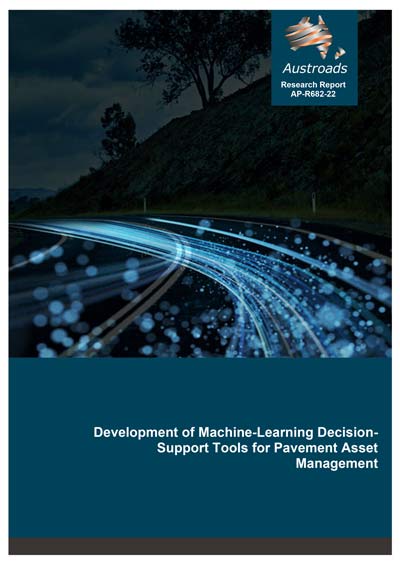Asset Management

- Publication no: AP-R682-22
- ISBN: 978-1-922700-63-6
- Published: 20 December 2022
- PDF (free) Download
This report explores the use of Artificial Intelligence (AI) and Machine-Learning (ML) in pavement asset management and details a methodology for developing new use-cases. While there are some existing uses of AI and ML technology in pavement asset management the development of new use-cases have often failed due to the inappropriate use of data and models, and difficulty articulating the constraints of different technical disciplines.
Two case studies demonstrate the application of the methodology using data from four member authorities.
The first case study sought to understand to what extent, historic condition, inventory and treatment data could be used to train machine learning models to reproduce expert pavement asset management decisions. Models were developed and evaluated on four Austroads member authority datasets, predicting six treatment classes over four future time-horizons. Treatment predictions were made for short road sections prior to clustering into candidate projects. The results were promising, and suggest that with further development machine learning models could provide decision support and efficiency gains to programme developers.
The second case study explored an extension to conventional Pavement Management System (PMS) optimisation to provide insight into the network-wide implications of various multi-criteria funding allocation scenarios. The resulting data captures the implications of all achievable funding splits (freight / non-freight routes, and metropolitan / regional routes) on network Level of Service. The project team developed a system to achieve specific multi-criteria splits using existing PMS optimisation tools, which suggests this methodology could be adopted without significant disruption or risk.
Code
The two case studies were developed using open-source Python data science tools, such as Python, NumPy and Pandas.
The code, with instructions, can be downloaded from github.com/Austroads/aam6201
This Quick Reference contains a set of practical resources to help Austroads member authorities develop small teams to explore new AI/ML projects and successfully prosecute research and development through to integration into existing business processes. It includes resources which can help you define and scope projects, form teams, recruit specialists, manage projects, understand key terminology and concepts, and assess the viability and risks of specific project ideas.
Watch the first webinar in a two-part series with authors Tim Cross and David Rawlinson. The session describes tips, tricks and success strategies to ensure AI/ML projects proceed to delivery and successful integration with existing business processes. The presenters introduce the Quick Reference document with practical examples on how to use it.
Watch the second webinar on the Development of Machine Learning Decision Support Tools for Pavement Asset Management.
- Summary
- Case Study 1: Project Identification
- Case Study 2: Funding Allocation
- Recommendations
- Quick Reference
- 1 Introduction
- 1.1 Purpose
- 1.2 Scope
- 2 Literature Review
- 2.1 Introduction to Artificial Intelligence and Machine Learning
- 2.1.1 Key Concepts
- 2.1.2 Project Risk Mitigation
- 2.1.3 Ethical and Responsible AI/ML
- 2.1.4 Bias
- 2.1.5 Importance of Effective Model Validation
- 2.1.6 Key Success Factors
- 2.2 Application to Pavement Asset Management
- 2.2.1 Pavement Asset and Condition Identification
- 2.2.2 Asset Condition Assessment
- 2.2.3 Pavement Deterioration Modelling
- 2.2.4 Network Renewal Planning Optimisation
- 2.1 Introduction to Artificial Intelligence and Machine Learning
- 3 Methodology
- 3.1 Requirements Analysis
- 3.2 Data Collation, Pre-processing and Exploratory Analysis
- 3.2.1 Dataset Transformation
- 3.2.2 Samples and Features
- 3.2.3 Exploratory Analysis
- 3.2.4 Data Encoding
- 3.2.5 Normalisation
- 3.3 Solution Development
- 3.4 Model Validation and Assessment
- 3.4.1 Quantitative Performance Measurement
- 3.4.2 Performance Stability
- 3.4.3 Qualitative Assessment
- 3.5 Outcomes and Adoption – Decision Support
- 4 Case Study 1: Project Identification
- 4.1 Requirements Analysis
- 4.2 Data Collation, Pre-processing and Exploratory Analysis
- 4.2.1 Road-sectioning and Chainage Representation
- 4.2.2 Feature Encoding
- 4.2.3 Treatment Encoding
- 4.3 Solution Development
- 4.4 Model Validation and Assessment
- 4.4.1 Quantitative Performance Analysis
- 4.4.2 Project-Level Performance Analysis
- 4.4.3 Qualitative Analysis of Learned Feature-Treatment Relationships
- 4.4.4 Intervention Triggers
- 4.4.5 Transfer Policy Experiment and Analysis
- 4.5 Outcomes and Adoption
- 4.5.1 Key Findings
- 4.5.2 Further Work
- 4.5.3 Lessons Learned
- 5 Case Study 2: Funding Allocation
- 5.1 Requirements Analysis
- 5.2 Data Collation, Processing and Exploratory Analysis
- 5.3 Solution Development
- 5.3.1 Optimisation Overview
- 5.3.2 Project Selection Optimisation
- 5.3.3 Meta-Heuristic Grid-Search Optimisation
- 5.3.4 Formal Problem Definition
- 5.4 Model Validation and Assessment
- 5.4.1 Fixed Budget Scenario
- 5.4.2 Level of Service in Penalty Space
- 5.4.3 Level of Service by Funding Allocation
- 5.5 Outcomes and Adoption
- 5.5.1 Key Findings
- 5.5.2 Further Work
- 5.5.3 Lessons Learned
- 6 Conclusions and Recommendations
- 6.1 Conclusions
- 6.1.1 Case study 1: Feasibility of Reproducing Existing Practice
- 6.1.2 Case study 1: Feasibility of Applying Models to Other Road Networks
- 6.1.3 Case study 2: Feasibility of Multi-criteria Optimisation of Funding Allocation
- 6.2 Recommendations
- 6.2.1 Strategies for Successful Operationalisation
- 6.2.2 Strategic: Importance of Digital Engineering
- 6.2.3 Tactical: Keeping Pace on ML Research and Development
- 6.2.4 Operational: Building Long-term ML Capability
- 6.2.5 Operational: Fit-for-purpose Business Models for ML
- 6.1 Conclusions
- References
- Glossary
- Appendix A Project Identification
- A.1 Exploratory Analysis and Pre-processing
- A.2 Section-level and Project-level Results
- A.2.1 F-Score, Precision, and Recall Results for Rare Treatment Classes on Section- level Using
- Bootstrap Oversampling
- A.2.2 F-Score, Precision, and Recall Performance Stability Results for Common Treatment Classes at Section-level Without Bootstrap Sampling
- A.3 Project-level Performance
- A.4 Feature Effects
- Appendix B Funding Allocation
- B.1 Fixed Budget, Unweighted Pavement Condition Index
- B.1.1 Level of Service by Penalties
- B.1.2 Level of Service by Funding Allocation
- B.1.3 Level of Service by Funding Allocation, 2D
- B.2 Fixed budget, Lane-Length Weighted Pavement Condition Index
- B.2.1 Level of Service by Penalties
- B.2.2 Level of Service by Funding Allocation
- B.2.3 Level of Service by Funding Allocation, 2D
- B.1 Fixed Budget, Unweighted Pavement Condition Index

